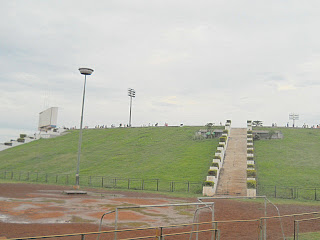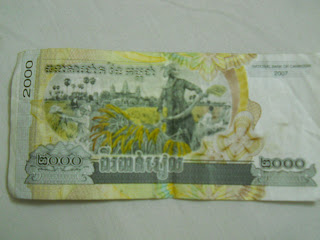 After six hours of journey via the south-eastern countryside of Cambodia,Malinh Bus finally reached its main office at Sihanouk Boulevard just beside the south bay section of the Olympic Stadium.
After six hours of journey via the south-eastern countryside of Cambodia,Malinh Bus finally reached its main office at Sihanouk Boulevard just beside the south bay section of the Olympic Stadium.I presume it must be the stadium parking lot and not a bus terminal.
As usual once you step out of the bus,the tuk-tuks drivers will be pestering you with their kind services.
This is the first time I'm getting off beside the stadium where normally I will get a bus that stops at Psar Thmey central bus terminal.
I overheard a tuk-tuk driver offering a ride for USD10 to a lady backpacker.I can't imagine such exorbitant rate. There was an afternoon shower and since it was just 1:25 pm as seen on the clock in Malinh's office,I sat in the office and reorganised myself looking at the handy map.
If you wished to go back to Ho Chi Minh City,this is the only place to book Malinh's bus ticket. The staff of Malinh Bus company were very courteous and will be very happy to show you the directions.
The Cambodia Map of Phnom Penh City which I got from the Airport lobby given free of charge.
The icon resembling the cross is the Psar Thmey central market.To walk there might take thirty minutes,paying a motordup if you're alone should be USD1.00 whereas a tuk-tuk USD2 should be reasonable.
By the way,airport to town by motordup is USD2 while tuk-tuk is USD5.
Straight ahead from Malinh Bus office exit left say twenty minutes walk is the Independence Monument and the riverside. The hexagonal green patch north east of Olympic Stadium is the Psar Orussey market.

The main entrance to the Olympic Stadium in Phnom Penh.
It is on a very high ground off Sihanouville Boulevard just near the corner shop housing the Cambodian Public Bank Ltd.
Along this stretch of road are all the motorcycle shops.Most of the shopfronts are five-storey building with balconies on the upper floors.
I had the opportunity to walk up one of the building with a guesthouse on the third floor to check it out.It only has five fan rooms with bathroom attached costing USD5 but all are unavailable. The owner is a young sweet lady who owned the premises with her family living on the lower floor.
One thing bad about the place is that there are no lightings along the dark stairways.
Phnom Penh's Olympic Stadium is very huge but unfortunately it was in a state of neglect.
The canteen is just like an ordinary night market pushcart stalls. In the evening,the stadium was filled with local joggers running round the tracks while on the upper platform near the seating areas are the aerobic dancers young and old partying to the tune of the folk songs blaring from their portable sound system.
It will a very relaxing evening to spend your time here especially with the cool breeze and the panoramic view of the city.

The Olympic Games is one of the world's most foremost sport competitions, a major international events featuring the summer and winter olympic.
They are held every four years and the next big one will be held in London,Great Britain.The olympic torch will be leaving Vancouver,Canada the previous games village very soon.
The Olympic Stadium in Phnom Penh sounds glamorous but none of the Olympic Games has been held here ever since it was built in 1964. During the Khmer Rouge era, the stadium was used as the site of executions by the Khmer Rouge of officials in the administration of Lon Nol,a self-appointed premier after coup-d'etat against Prince Norodum Sihanouk.
The seats around the terraces are cement flooring and can hold a capacity of 50,000 to 80,000 spectators.
Cambodian footballers are the main benefacto of this huge stadium as they have a better edge in terms of training facilities and a bigger home crowd advantage if there's any football competition.
Cambodian football clubs joined FIFA's ranks in 1953. Their national team nickname is The Royal Khmer Angkor Warriors.
In October 2007, Cambodia was eliminated from the 2010 World Cup qualifiers, at the first hurdle, losing 1–0 to Turkmenistan at home in Phnom Penh and 4–1 away in Ashgabat.
So now let's see whether they do qualify for the 2014 FIFA World Cup qualifying rounds.
Wat Preah Puth Mean Bon in the horizon. Hotels in that area around Street 336 are Salita Hotel,Hang Neak Hotel,Phkar Chhouk Tep Monireth,Star Wood Inn,Nokorsamreth Hotel,Lucky Star Hotel(casino with nightclub inside) and Phkar Chhouk Tep.
Rates from USD8 onwards.
Cambodian currency is called the Riel which includes both bank notes and coins.
The Riel banknotes that are currently in circulation include the following denominations; 50,100, 200, 500, 1,000, 2,000, 5,000, 10,000, 20,000, 50,000, and the 100,000 notes.
The Riel coins that are currently in circulation are the 50, 100, 200, and the 500.
The currency is only tradeable within the country and not good for exchange at money changers outside the country.The United States Dollar is widely used here.
Being a former colony of France until 1953,its monetary policy was governed by the French and at that time a monetary union was created which is equivalent to a central bank of Indochina(a region containing Vietnam, Cambodia, and Laos).
The current rate per USD is 4058 Cambodian Riels (KHR)
The 5,000 Riel(equivalent to USD1.20) front face has picture of naga head serpent and His MajestyNorodom Sihanouk.
At the currency's back is the antique bridge of "Kampong Kdei" in Siem Reap Province which is 264km from Phnom Penh City.
The bridge was erected by King Jayavarman VII in the late 12th century having a length of 80m and 14m wide and has twenty-one axes.
In fact this is the longest ancient bridge among the many others in the province.
The watermark on the banknote is Four faces of Bayon Temple at Angkor Thom.

The 2,000 KHR (Khmer Riel) shows the 5th gopura of Preah Vihear Temple which is the Soul of the Khmer people.
The temple is perched on the edge of a giant cliff, 625 meters above sea level in northern part of Preah Vihear Province.
Of late this area has been a disputed hotspot but the International Court of Justice (ICJ) in The Hague awarded the temple to Cambodia.
On July 7, 2008, Preah Vihear was listed as a UNESCO World Heritage Site.
The other side of the 2,000 Riel banknote shows a woman harvesting rice in the shadow of Angkor Wat.
Roughly equivalent to half a U.S. dollar.
On July 7, 2008, Preah Vihear was listed as a UNESCO World Heritage Site.
The other side of the 2,000 Riel banknote shows a woman harvesting rice in the shadow of Angkor Wat.
Roughly equivalent to half a U.S. dollar.
The 1,000 Cambodian Riel shows sculpture art of 10th century Banteay Srei temple printed in silver ink.
Banteay Srei temple located around Angkor is a Hindu temple dedicated to Lord Siva.
The popular sculpture of naga serpent and Victory Gate at Angkor Thom is also on the background.
The back of the 1,000 KHR shows the Port of Sihanoukville (Kampong Saom) which is the main trade point of Cambodia.
Banteay Srei temple located around Angkor is a Hindu temple dedicated to Lord Siva.
The popular sculpture of naga serpent and Victory Gate at Angkor Thom is also on the background.
The back of the 1,000 KHR shows the Port of Sihanoukville (Kampong Saom) which is the main trade point of Cambodia.
The town of Sihanoukville was the place of the last official battle of the United States army in the Vietnam War.
The watermark is a geometrical repeated pattern of flower-like ornaments.
500 KHR also has sculpture of naga head serpent and picture of Angkor Wat temple.

On the back of the 500-note is the Spien Kizuna bridge (Cambodia-Japan Friendship) across Mekong River in Kampong Cham town.
The watermark is a geometrical repeated pattern of flower-like ornaments.
500 KHR also has sculpture of naga head serpent and picture of Angkor Wat temple.

On the back of the 500-note is the Spien Kizuna bridge (Cambodia-Japan Friendship) across Mekong River in Kampong Cham town.
This first bridge over the Mekong River was opened in year 2001.
The bridge which is 75km north-east of the capital Phnom Penh is an important trade route within the Mekong region.
Spien in Khmer means bridge while Kizuna in English means "tie"
The watermark show some Khmer text.















































